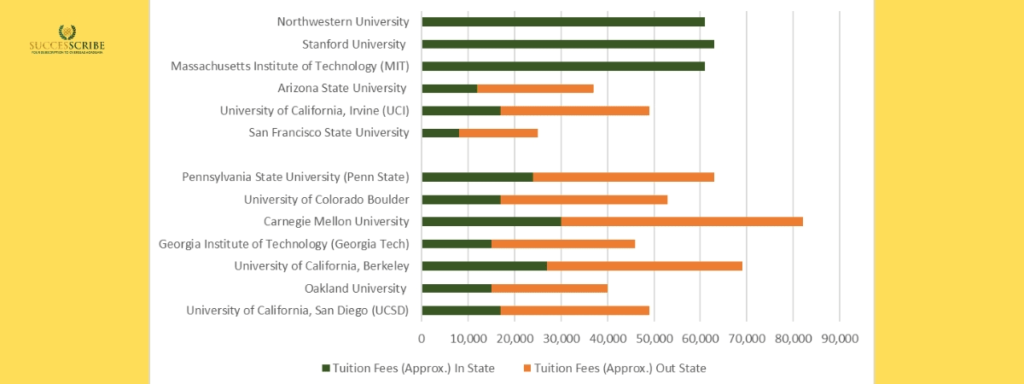Embedded systems are an integral part of many modern-day technologies, driving devices from smartphones to industrial machines, to medical equipment. As industries and consumers increasingly demand smarter and more connected devices, there is a growing need for skilled professionals in embedded systems. A Masters in Embedded Systems in USA provides the advanced knowledge and hands-on experience required to thrive in this rapidly expanding field.
This topic will explore everything you need to know about pursuing a Master’s in Embedded Systems in the USA, from the best universities offering the program to job opportunities and the potential career path post-graduation.
What Are Embedded Systems?

An embedded system refers to a specialized computing system that is designed to handle specific tasks within a larger system. Unlike general-purpose computers, embedded systems are optimized for particular functions and are integral to the performance of devices in industries ranging from consumer electronics to automotive systems.
These systems typically consist of:
- Microcontrollers or Microprocessors: Central processing units responsible for executing the tasks.
- Memory: Storage components to hold data and software.
- Input/Output (I/O) Devices: Interfaces that allow communication with other systems.
- Software or Firmware: The specialized code that operates the system.
Embedded systems are found in various applications like home appliances, cars, medical equipment, and many industrial machines.
Also Read: Bachelor in Computer Science in USA
Top Reasons to Pursue a Masters in Embedded Systems in USA?
Opting for a Master’s degree in Embedded Systems in the USA comes with several distinct advantages:
- Advanced Curriculum: Universities in the USA offer cutting-edge programs incorporating the latest trends such as IoT (Internet of Things), real-time systems, and artificial intelligence.
- Top-ranked Universities: The USA is home to prestigious institutions providing specialized embedded systems programs with strong industry connections.
- Career Opportunities: With the growing use of embedded systems across diverse industries, there is an increasing demand for skilled professionals in fields like IoT, automotive technology, robotics, and consumer electronics.
- Networking: Being in proximity to major tech hubs such as Silicon Valley provides students with access to internship opportunities, workshops, and potential employment avenues.
Top Universities for Masters in Embedded Systems in USA

Here’s a comprehensive table of top universities offering Masters programs in Embedded Systems in the United States:
| University | Ranking (Engineering) | Type | Program Name | Tuition Fees (Approx.) |
| University of California, San Diego (UCSD) | #11 | Public | MS in Embedded Systems | $17,000/year (in-state), $32,000/year (out-of-state) |
| Oakland University | Not Ranked | Public | MS in Embedded Systems | $15,000/year (in-state), $25,000/year (out-of-state) |
| University of California, Berkeley | #3 | Public | MEng in Robotics and Embedded Software | $27,000/year (in-state), $42,000/year (out-of-state) |
| Georgia Institute of Technology (Georgia Tech) | #5 | Public | MS in Electrical and Computer Engineering (Embedded Systems) | $15,000/year (in-state), $31,000/year (out-of-state) |
| Carnegie Mellon University | #13 | Private | Master of Software Engineering – Embedded Systems | $30,000/year (in-state), $52,000/year (out-of-state) |
| University of Colorado Boulder | #23 | Public | MS in Electrical, Computer, and Energy Engineering (Embedded Systems Focus) | $17,000/year (in-state), $36,000/year (out-of-state) |
| Pennsylvania State University (Penn State) | #28 | Public | MS in Electrical Engineering (Embedded Systems Focus) | $24,000/year (in-state), $39,000/year (out-of-state) |
| Northwestern University | #18 | Private | MS in Computer Engineering (Embedded Systems) | $61,000/year |
| San Francisco State University | Not ranked | Public | MS in Computer Engineering (Embedded Systems Focus) | $8,000/year (in-state), $17,000/year (out-of-state) |
| University of California, Irvine (UCI) | #30 | Public | MS in Embedded and Cyber-Physical Systems | $17,000/year (in-state), $32,000/year (out-of-state) |
| Arizona State University | #41 | Public | MS in Computer Engineering (Embedded Systems) | $12,000/year (in-state), $25,000/year (out-of-state) |
| Massachusetts Institute of Technology (MIT) | #1 | Private | MS in Electrical Engineering and Computer Science (EECS) | $61,000/year |
| Stanford University | #2 | Public | MS in Electrical Engineering (Embedded Systems Focus) | $63,000/year |
Also Read: Masters in cyber security in USA
Acceptance Rates for International Students – MS in Embedded Systems in the USA

If you are applying as an international student for an MS in Embedded Systems in the USA, it’s important to understand that the acceptance rates may be slightly lower compared to domestic applicants. Here’s the estimated acceptance rate for international students at these top universities:
| University | Acceptance Rate for International Students (Approx.) |
| University of California, San Diego (UCSD) | 22% |
| Oakland University | 78% |
| University of California, Berkeley | 9% |
| Georgia Institute of Technology (Georgia Tech) | 11% |
| Carnegie Mellon University | 11% |
| University of Colorado Boulder | 58% |
| Pennsylvania State University (Penn State) | 43% |
| Northwestern University | 7% |
| San Francisco State University | 88% |
| University of California, Irvine (UCI) | 19% |
| Arizona State University (ASU) | 73% |
| Massachusetts Institute of Technology (MIT) | 5% |
| Stanford University | 4% |
Also Read: Masters in data science in USA
Admission Requirements and Application Process
Gaining admission to a Master’s program in Embedded Systems at top US universities is competitive, with acceptance rates ranging from 8% to 25% depending on the institution. Understanding the typical requirements and preparation strategies can significantly improve your chances of acceptance.
Standard Admission Requirements
| Requirement | Description |
| Bachelor’s Degree | In electrical engineering, computer engineering, computer science, or related field |
| Academic Performance | Minimum GPA of 3.0-3.5 on a 4.0 scale (varies by university) |
| GRE Score | Typically 155+ Quantitative, 150+ Verbal (top programs may expect 165+ Quantitative) |
| IELTS/TOEFL (International) | IELTS: 7.0-7.5TOEFL: 90-100 iBT |
| Letters of Recommendation | 2-3 letters, preferably from academic sources or industry professionals |
| Statement of Purpose | Focused on embedded systems interests, research goals, and career plans |
| Resume/CV | Highlighting relevant projects, internships, work experience |
| Prerequisites | Courses in digital systems, computer architecture, programming, and electronics |
Application Timeline

Planning ahead is critical to submitting a strong application for Embedded Systems programs in the U.S. Here’s a typical timeline that most students follow:
| Timeline | Action Steps |
| 12–15 months before intake | Research programs, check eligibility, and shortlist universities. |
| 10–12 months before intake | Prepare and take GRE and TOEFL/IELTS exams. |
| 8–10 months before intake | Draft Statement of Purpose, gather Letters of Recommendation. |
| 6–8 months before intake | Submit university applications before deadlines. |
| 4–6 months before intake | Receive admission decisions, finalize university choice. |
| 3–4 months before intake | Apply for student visa (F-1 Visa) and arrange housing. |
| 1–2 months before intake | Plan travel, attend pre-departure orientations, and fly to the USA. |
Visa Process for Masters in Embedded Systems in USA
Start your visa process 3–4 months before your course begins to avoid delays.
| Step | Description |
| Receive Form I-20 | Get the Form I-20 from your admitted university. |
| Pay SEVIS Fee | Pay the SEVIS fee ( Estimated – $350) online. |
| Complete DS-160 Form | Fill out the online visa application form (DS-160). |
| Schedule Visa Interview | Book an appointment at the nearest U.S. Embassy or Consulate. |
| Attend Visa Interview | Carry all documents and attend the visa interview confidently. |
| Visa Decision | If approved, receive your F-1 visa and prepare for travel. |
Also Read: Masters in digital marketing in USA
Tuition Fees and Living Expenses for a Master’s in Embedded Systems in USA
Pursuing a Masters in Embedded Systems in USA requires careful financial planning. The overall cost typically consists of two major components: tuition fees and living expenses. Here’s a detailed breakdown:
Tuition Fees
Tuition fees for Master’s programs in Embedded Systems vary depending on the university, program duration, and whether the student is attending a public or private institution. On average:
| Type of University | Annual Tuition Fee Range (USD) |
| Public Universities (State-funded) | $20,000 – $40,000 |
| Private Universities | $40,000 – $65,000 |
Living Expenses
Living expenses vary widely depending on the city, lifestyle, and accommodation choices. On average, the estimated living cost for international students in the USA includes:
| Expense Type | Monthly Cost (USD) | Annual Cost (USD) |
| Accommodation (Rent) | $800 – $1,500 | $9,600 – $18,000 |
| Groceries | $200 – $400 | $2,400 – $4,800 |
| Transportation | $70 – $150 | $840 – $1,800 |
| Medical Insurance | $100 – $300 | $1,200 – $3,600 |
| Books and Supplies | $50 – $100 | $600 – $1,200 |
| Miscellaneous Expenses | $100 – $200 | $1,200 – $2,400 |
Estimated Total Living Cost per Year: $15,000 – $30,000
Living costs can vary based on the city:
- Cheaper Cities: Austin, Houston, Pittsburgh
- Expensive Cities: New York City, San Francisco, Los Angeles
Total Estimated Cost for Masters in Embedded Systems in USA
Considering a 2-year program:
| Cost Component | Total Estimated Cost (USD) |
| Tuition Fees | $40,000 – $130,000 |
| Living Expenses | $30,000 – $60,000 |
| Overall Estimated Cost | $70,000 – $190,000 |
Also Read: Masters in robotics in USA
Scholarships Available for Masters in Embedded Systems in USA

Pursuing a Master’s degree in Embedded Systems from the United States is a dream for many students. However, the cost can be significant, especially when considering tuition fees, living expenses, and additional costs like health insurance. Thankfully, there are many scholarships and funding options available that can make studying in the U.S. much more affordable for international students.
Let’s explore the different types of scholarships you can apply for:
Government-Funded Scholarships
International students are also eligible to apply for several prestigious scholarships funded by the U.S. government.
| Scholarship Name | Funded By | Support Provided |
| Fulbright Foreign Student Program | U.S. Department of State | Full tuition, living stipend, airfare, and health insurance |
| Hubert H. Humphrey Fellowship Program | U.S. Government | Fully-funded program including tuition and professional training |
| AAUW International Fellowships | American Association of University Women | Full tuition fees and living expenses for women pursuing graduate study |
| EducationUSA Opportunity Funds Program | U.S. Government | Covers application fees, visa expenses, standardized testing, and travel costs for financially needy students |
Indian Scholarships for Masters in Embedded Systems in USA
Indian students aiming to pursue a Master’s in Embedded Systems in the United States can benefit from several scholarship programs funded by the Indian government, private foundations, and charitable organizations.
| Scholarship Name | Funded By | Support Provided |
| Inlaks Shivdasani Foundation Scholarships | Inlaks Shivdasani Foundation | Full or partial tuition, living expenses, and one-way travel allowance |
| Fulbright-Nehru Master’s Fellowships | United States-India Educational Foundation (USIEF) | Full funding including tuition, living expenses, and travel costs |
| JN Tata Endowment Loan Scholarship | Tata Trusts | Partial financial assistance (loan scholarship) with travel grants |
| Aga Khan Foundation International Scholarship Programme | Aga Khan Foundation | 50% grant and 50% loan covering tuition fees and living expenses |
| Narotam Sekhsaria Foundation Scholarship | Narotam Sekhsaria Foundation | Interest-free loan scholarship covering tuition and living expenses |
University-Specific Scholarships
Many top universities in the U.S. offer scholarships or financial aid specifically tailored for graduate engineering students, including those pursuing Embedded Systems.
| University | Scholarship/Fellowship Name | Key Benefits |
| Stanford University | Knight-Hennessy Scholars Program | Full tuition, monthly stipend, and travel allowance |
| MIT | MIT Tata Fellowship | Full tuition + stipend |
| Carnegie Mellon University | College of Engineering Scholarships | Partial tuition fee waiver based on merit |
| University of California, Berkeley | Berkeley Graduate Fellowship | Covers tuition and provides a living stipend |
| University of Michigan, Ann Arbor | Rackham Merit Fellowship | Full or partial tuition support with stipend |
| University of Texas at Austin | Graduate School Fellowships | Competitive funding packages for outstanding applicants |
Also Read: MBA colleges in USA
Curriculum Overview of a Master’s in Embedded Systems
The structure of a Masters in Embedded Systems in USA typically includes both core courses and elective courses, alongside a project or thesis component. Here’s a breakdown of typical subjects:
Core Courses:
- Introduction to Embedded Systems: Learn the fundamentals of microcontrollers, sensors, and actuators used in embedded applications.
- Digital Circuits & Microprocessor Design: Study the design and functioning of digital circuits and microprocessors that form the backbone of embedded systems.
- Real-Time Operating Systems (RTOS): Learn about real-time constraints, operating systems, and how they apply to embedded systems.
- Embedded Software Development: Focus on software programming for embedded systems using C, C++, and other low-level programming languages.
- System on Chip (SoC) Design: Explore SoC technology, its design, and its application in embedded systems.
Elective Courses:
- IoT Systems and Applications: Study the design and implementation of IoT-based embedded systems.
- Wireless Communication Systems: Learn the fundamentals of communication protocols such as Wi-Fi, Bluetooth, Zigbee, and others used in embedded systems.
- VLSI (Very Large-Scale Integration) Design: Focus on the design and fabrication of complex integrated circuits used in embedded devices.
- Embedded System Security: Delve into the security challenges and solutions associated with embedded systems.
Capstone Project/Thesis:
Many programs require students to undertake a research project or thesis, where they apply their theoretical knowledge to solve practical problems in embedded systems.
Also Read: MBA in USA without work experience
Key Skills Acquired During the Program
A Master’s in Embedded Systems provides graduates with technical and professional skills, such as:
- Programming Languages: C, C++, Python, and Assembly language.
- Microprocessor and Microcontroller Design: In-depth knowledge of processor architecture and integration.
- Real-time System Management: Skills in managing time-critical applications in embedded systems.
- System Integration: Combining hardware and software to develop fully functional systems.
- Project Management: Planning, executing, and managing projects in team environments
Career Outlook for Embedded Systems Graduates

The embedded systems industry is expected to grow significantly as technology continues to evolve. Here’s a table showcasing common job roles and the average salaries for professionals with a Master’s in Embedded Systems:
| Job Title | Average Salary (USD) | Job Description |
| Embedded Systems Engineer | $95,000 | Design and test embedded systems in various sectors, including consumer electronics and automotive. |
| Firmware Engineer | $92,000 | Develop software that directly interfaces with hardware. |
| IoT Developer | $105,000 | Create and optimize IoT-based applications and systems. |
| Embedded Software Engineer | $98,000 | Develop embedded software for systems, often in C or C++. |
| Systems Architect | $120,000 | Design embedded system architectures for specific applications. |
| Embedded Systems Designer | $95,000 | Specialize in the physical design of embedded systems, including hardware selection. |
Conclusion
Pursuing a Masters in Embedded Systems in USA offers a wealth of opportunities for students aiming to build a successful career in technology and innovation. With access to world-renowned universities, cutting-edge research facilities, and strong industry connections, graduates are well-positioned to thrive in diverse fields such as IoT, automotive technology, healthcare devices, and consumer electronics. Although the financial investment can be significant, numerous scholarships and funding options can help ease the burden. By carefully planning your application process, meeting admission requirements, and preparing for life in the U.S., you can unlock the door to an exciting and rewarding future in embedded systems engineering.
FAQs
What skills should I have before starting a Master’s in Embedded Systems?
Strong fundamentals in C/C++ programming, knowledge of microcontrollers and microprocessors, understanding of real-time operating systems (RTOS), and basic hardware design skills are highly recommended.
What subjects are commonly covered in an Embedded Systems Master’s program?
Typical subjects include Embedded Programming, Real-Time Systems, Digital Signal Processing, Microcontroller Applications, System-on-Chip Design, Wireless Sensor Networks, and Cybersecurity for Embedded Systems.
Is work experience required to apply for an MS in Embedded Systems?
Work experience is not mandatory for most universities. However, having internships or professional experience in electronics, computer engineering, or software development can strengthen your application and improve your job prospects after graduation.
Can I get a job in the USA after completing my MS in Embedded Systems?
Yes, Embedded Systems graduates are in high demand across industries like automotive, aerospace, healthcare, and technology. With a STEM degree, you can also apply for up to 3 years of OPT (Optional Practical Training) in the USA, giving you ample time to find employment.
What is the difference between Embedded Systems and IoT courses?
Embedded Systems focus on designing and developing hardware-software systems within devices. IoT (Internet of Things) courses expand on Embedded Systems by teaching how devices communicate over the internet. Some universities offer specialization tracks that combine both.
Which companies hire Embedded Systems graduates in the USA?
Top recruiters include Intel, Qualcomm, Apple, Tesla, NVIDIA, Boeing, Microsoft, Amazon, General Motors, and Lockheed Martin, among many others.
Related Post
Masters in finance in USA
Masters in food science and technology in USA
Masters in health administration in USA
Masters in health informatics in USA















